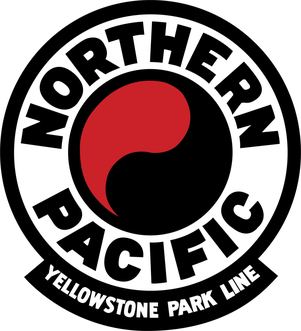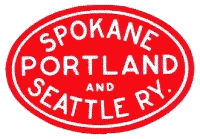Early history
In 1857, the territorial legislature of the state of Minnesota issued a charter to the Minnesota and Pacific Railroad to build a standard gauge railway from Stillwater in the east to St. Paul in the west. [3] From St. Paul, the main line would extend to Breckenridge in the west (the state's border with the Dakota Territory), while a branch line would extend to St. Cloud, Crow Wing, and St. Vincent. [3] As the state's first active railroad (though not necessarily the state's first railroad), the Minnesota and Pacific received a grant of 2,460,000 acres (1,000,000 ha) of land from the territorial legislature. [5] This was the seventh largest land grant of the 75 given to railroads nationwide between 1850 and 1871.
Construction began in the autumn of 1856, and in 1857 the state backed a $5 million bond issue to support the new rail system. But speculators manipulated the nascent railroad's profits, overcharged it for supplies, and sold off some of its assets. [7] It went bankrupt in 1860, and the new state legislature purchased all of its assets for a mere $1,000.
Saint Paul and Pacific
In 1862, the state legislature reorganized the bankrupt railroad as the St. Paul and Pacific Railroad. That same year, 10 miles (16 km) of track between St. Paul and St. Anthony finally opened. [2] Egbert E. Litchfield bought most of the road's stock, and while the branch line reached Sauk Rapids by 1867 (financed mostly by bonds sold in the Netherlands) little was accomplished on the main line. [9] Only 210 miles (340 km) of track had been laid as of 1865. [2] The railroad built almost no more track between 1867 and 1871. Nonetheless, it heavily promoted the construction of towns every 8 miles (13 km) along its length, and was the leading railroad helping to "colonize" Minnesota. [10]
In December 1870, the Northern Pacific Railway purchased the SP&P. [9] But the Northern Pacific went bankrupt in the Panic of 1873, and E. Darwin Litchfield (Egbert's brother) bought the SP&P back from the bigger road. [9] Dutch investors held most of the road's stock, and forced Litchfield to allow a receiver to manage the system. For three more years, little was done by the receiver.
But James J. Hill, who ran steamboats on the Red River, knew that the SP&P owned very valuable land grants and saw the potential of the railroad. Hill convinced John S. Kennedy (a New York City banker who had represented the Dutch bondholders), Norman Kittson (Hill's friend and a wealthy fur trader), Donald Smith [15] (a Montreal banker and executive with the Hudson's Bay Company), and George Stephen (Smith's cousin [15] and a wealthy railroad executive) to invest $5.5 million in purchasing the railroad. On March 13, 1878, the Dutch formally signed an agreement transferring their bonds to the investors group and giving them control of the railroad.
To finance construction of the SP&P, the road issued bonds that allowed the bearer to receive up to $10,000 per mile of track completed, but only if the line was finished. In February 1879, the group bought out the Litchfields with cash and bonds in the new company. [9] The SP&P showed a $500,000 profit for 1878, and in March 1879 two different courts finally approved the company's emergence from bankruptcy.
Demise and future ownership
On May 23, 1879, the key investors in the railroad formed a new company, the St. Paul, Minneapolis and Manitoba Railway (StPM&M), to take over the assets of the SP&P. It did so in June 1879, bringing an end to the existence of the St. Paul and Pacific.
On September 18, 1889, Hill changed the name of the Minneapolis and St. Cloud Railway (a railroad which existed primarily on paper, but which held extensive land grants throughout the Midwest and Pacific Northwest) to the Great Northern Railway. [21] On February 1, 1890, he transferred ownership of the StPM&M, Montana Central Railway, and other rail systems he owned to the Great Northern. [21]
Starting in 2018, Minnesota-based Progressive Rail Corp. runs freight trains in Santa Cruz County, California under the same name St. Paul and Pacific and with the same reporting marks SP&P/SPP. [22] [23]

James Jerome Hill was a Canadian-American railway director. He was the chief executive officer of a family of lines headed by the Great Northern Railway, which served a substantial area of the Upper Midwest, the northern Great Plains, and the Pacific Northwest in the United States. Because of the size of this region and the economic dominance exerted by the Hill lines, Hill became known during his lifetime as "The Empire Builder", and died in 1916 with a fortune of about 63 million dollars. His former home, James J. Hill House, is now a museum in Saint Paul, Minnesota.

The Great Northern Railway was an American Class I railroad. Running from Saint Paul, Minnesota, to Seattle, Washington, it was the creation of 19th-century railroad entrepreneur James J. Hill and was developed from the Saint Paul & Pacific Railroad. The Great Northern's route was the northernmost transcontinental railroad route in the U.S.

The Burlington Northern Railroad was a United States–based railroad company formed from a merger of four major U.S. railroads. Burlington Northern operated between 1970 and 1995.

The Southern Pacific was an American Class I railroad network that existed from 1865 to 1996 and operated largely in the Western United States. The system was operated by various companies under the names Southern Pacific Railroad, Southern Pacific Company and Southern Pacific Transportation Company.

The Chicago, Milwaukee, St. Paul and Pacific Railroad (ACMStP&P), better known as the Milwaukee Road, was a Class I railroad that operated in the Midwest and Northwest of the United States from 1847 until 1986.

The Northern Pacific Railway was an important transcontinental railroad that operated across the northern tier of the western United States, from Minnesota to the Pacific Northwest. It was approved and chartered in 1864 by the 38th Congress of the United States in the national / federal capital of Washington, D.C., during the last years of the American Civil War (1861-1865), and given nearly 40 million acres of adjacent land grants, which it used to raise additional money in Europe, for construction funding.

The Chicago and North Western was a Class I railroad in the Midwestern United States. It was also known as the "North Western". The railroad operated more than 5,000 miles (8,000 km) of track at the turn of the 20th century, and over 12,000 miles (19,000 km) of track in seven states before retrenchment in the late 1970s. Until 1972, when the employees purchased the company, it was named the Chicago and North Western Railway.

The Spokane, Portland & Seattle Railway was a railroad in the northwest United States. Incorporated in 1905, it was a joint venture by the Great Northern Railway and the Northern Pacific Railway to build a railroad along the north bank of the Columbia River. The railroad later built or acquired other routes in Oregon. The SP&S was merged into the Burlington Northern in March, 1970. Remnants of the line are currently operated by BNSF Railway and the Portland and Western Railroad.

The Minneapolis, Northfield and Southern Railway was an 87-mile (140 km) long American shortline railroad connecting Minneapolis and Northfield, Minnesota. It was incorporated in 1918 to take over the trackage of the former Minneapolis, St. Paul, Rochester and Dubuque Electric Traction Company, also known as the Dan Patch Lines. On June 2, 1982, it was acquired by the Soo Line Railroad, which operated it as a separate railroad until merging it on January 1, 1986, along with the Chicago, Milwaukee, St. Paul and Pacific Railroad.

The Texas and Pacific Railway Company was created by federal charter in 1871 with the purpose of building a southern transcontinental railroad between Marshall, Texas, and San Diego, California.

Progressive Rail Inc. is a shortline railroad and owner of several other shortlines. PGR is directly operating several separate branches in Minnesota including the Airlake Terminal Railway. Progressive Rail also acquired the Wisconsin Northern Division in Chippewa Falls, Wisconsin and operates as a separately-named division. They also own the Chicago Junction Railroad, Clackamas Valley Railway, the Iowa Traction Railway and Iowa Southern Railway in Iowa, the Crab Orchard and Egyptian Railroad in Illinois, the St. Paul & Pacific Northwest Railroad, and the Wisconsin Northern Railroad.

The Chicago, St. Paul, Minneapolis and Omaha Railway or Omaha Road was a railroad in the U.S. states of Nebraska, Iowa, Minnesota, Wisconsin and South Dakota. It was incorporated in 1880 as a consolidation of the Chicago, St. Paul and Minneapolis Railway and the North Wisconsin Railway. The Chicago and North Western Railway (C&NW) gained control in 1882. The C&NW leased the Omaha Road in 1957 and merged the company into itself in 1972. Portions of the C. St. P. M. and O. are part of the Union Pacific Railroad network. This includes main lines from Wyeville, Wisconsin, to St. Paul, Minnesota, and St. Paul to Sioux City, Iowa.

Wayzata station is a historic train depot in Wayzata, Minnesota, United States. Constructed and operated by the Great Northern Railway, the station was in service from 1906 until 1971. The depot is positioned along Lake Minnetonka in downtown Wayzata with steps leading down to the lakeshore. Although no longer transporting passenger trains, the BNSF Railway line going through Wayzata is still active today.
The following is a brief history of the North American rail system, mainly through major changes to Class I railroads, the largest class by operating revenue.
The following is a brief history of the North American rail system, mainly through major changes to Class I railroads, the largest class by operating revenue.

Charles Elliott Perkins was an American businessman and president of the Chicago, Burlington and Quincy Railroad. He was so well respected that historian Richard Overton wrote, "From the time that Charles Elliott Perkins became vice president of the Chicago, Burlington and Quincy [1876] ... until he resigned as president in 1901, he was the Burlington."
The Montana Central Railway was a railway company which operated in the American state of Montana from 1886 to 1907. It was constructed by James Jerome Hill's St. Paul, Minneapolis & Manitoba Railway, and became part of the Great Northern Railway in 1889.
The Winona and St. Peter Railroad was a railroad in the Midwestern United States. It was founded in 1861 in Winona, Minnesota. The first 11 miles (18 km) from Winona to Stockton, Minnesota, were completed by the end of 1862, making the it the second operational railroad in Minnesota, after the St. Paul and Pacific Line from Saint Paul to St. Anthony Falls.
The history of the Southern Pacific ("SP") stretched from 1865 to 1998.













